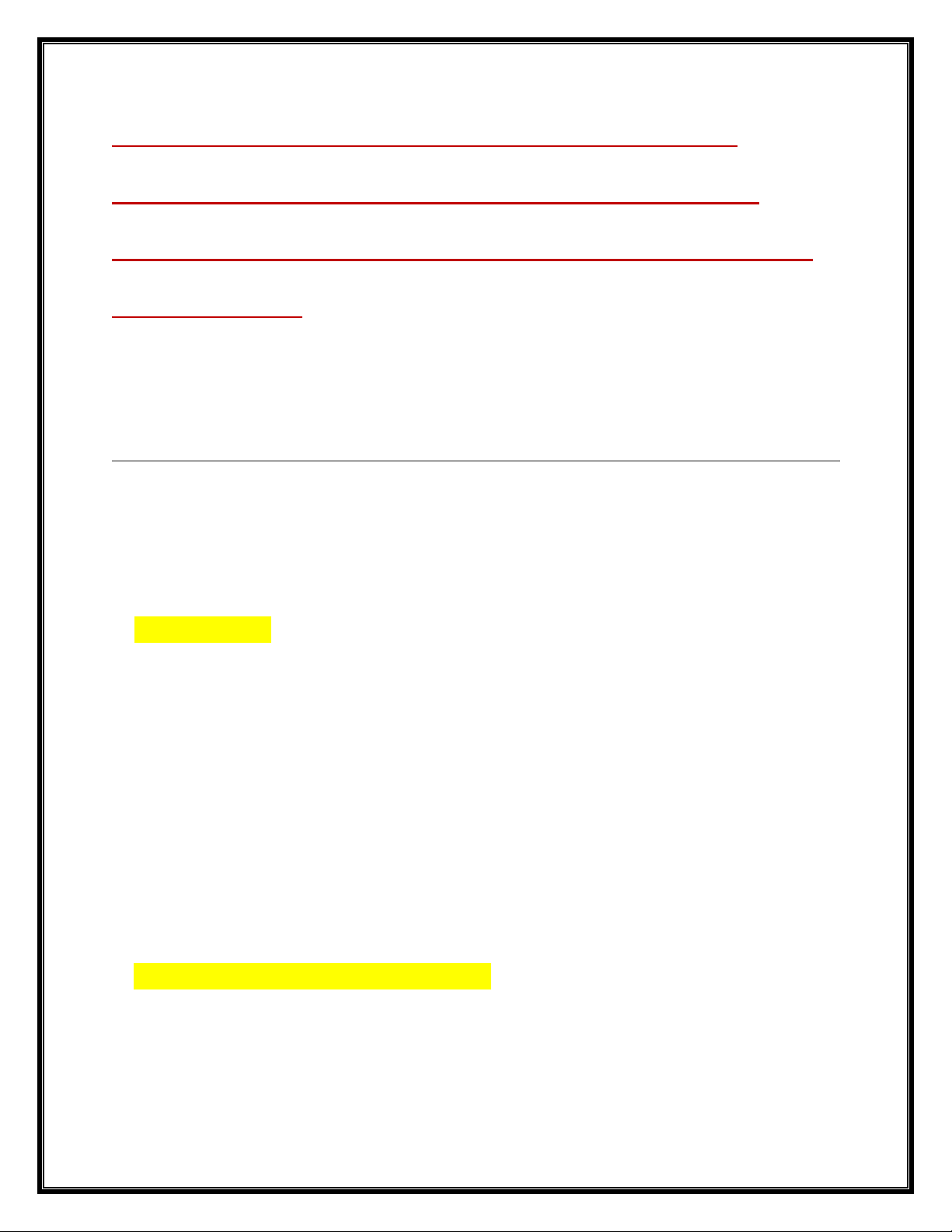
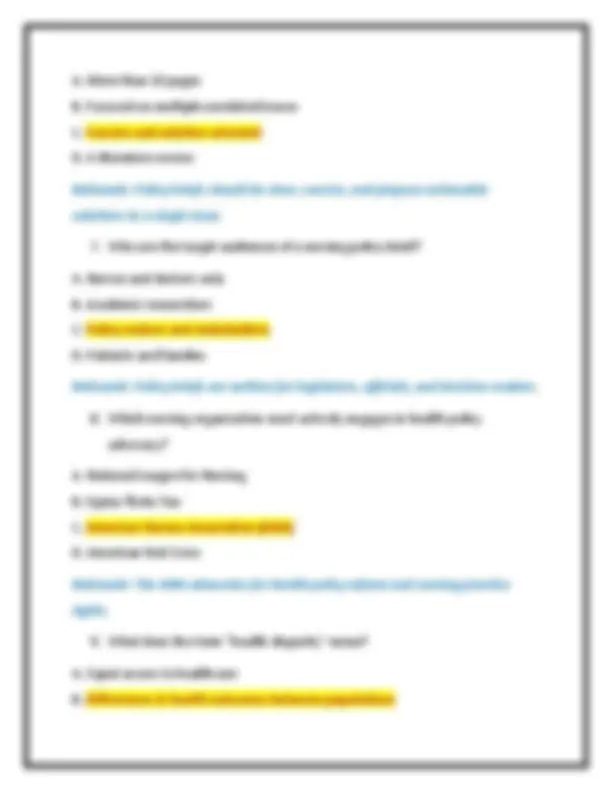
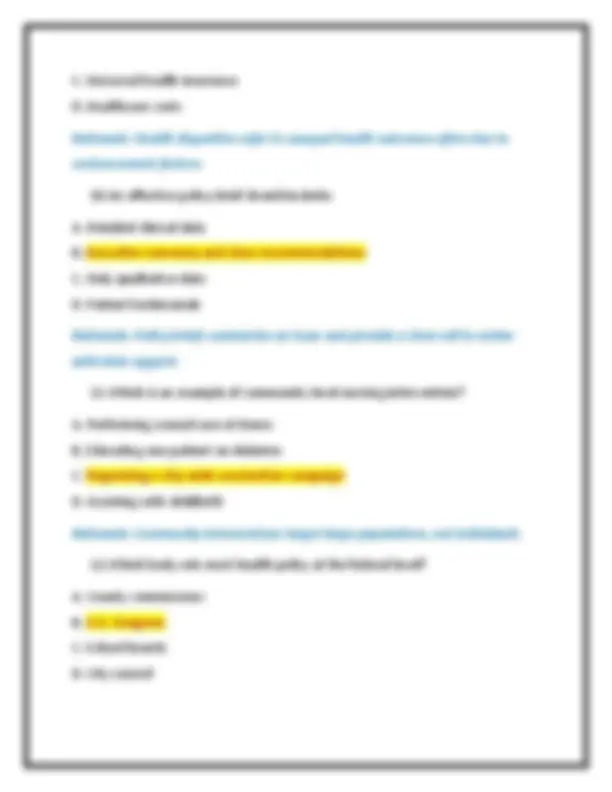
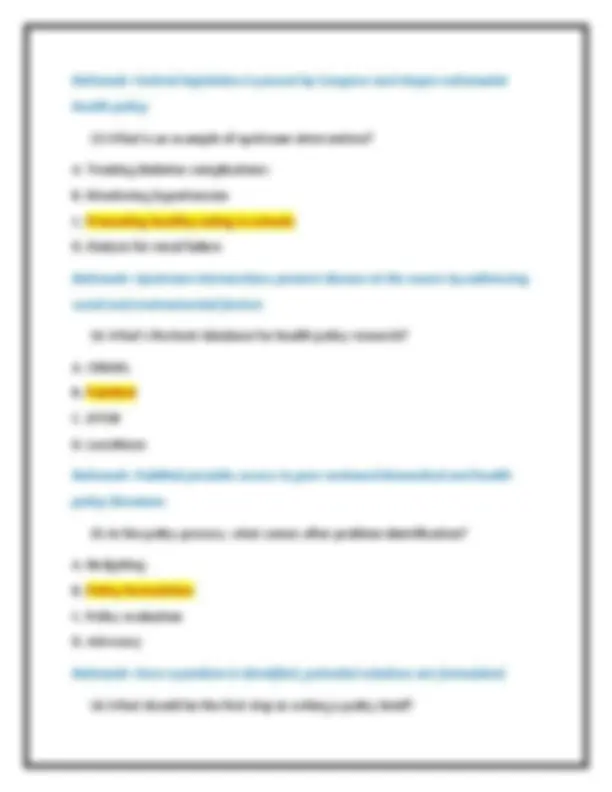
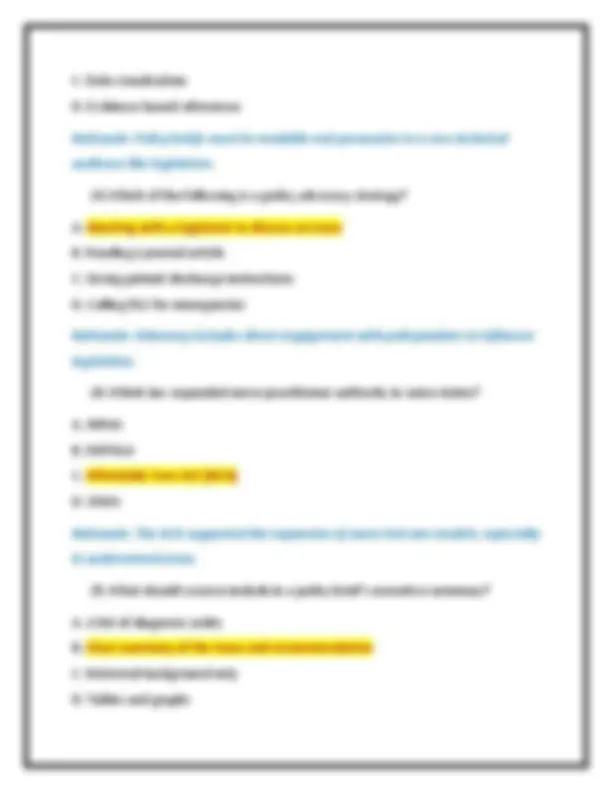
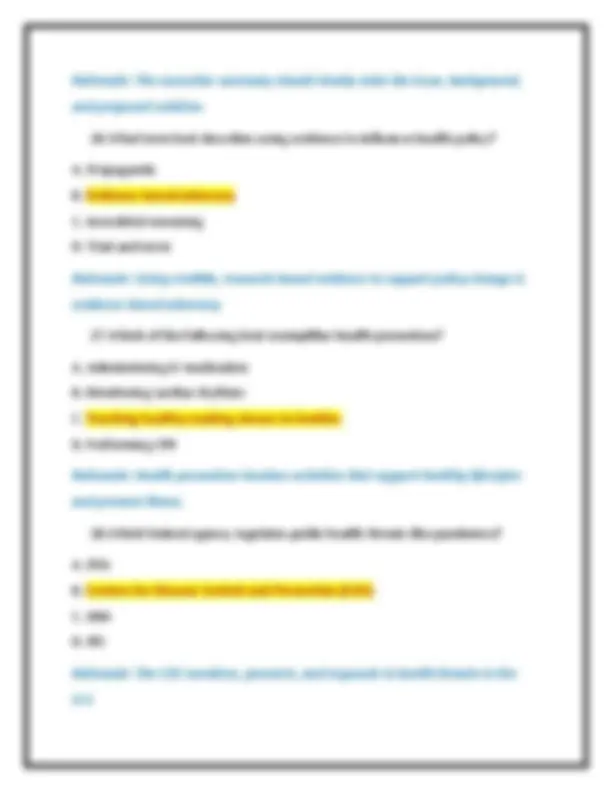
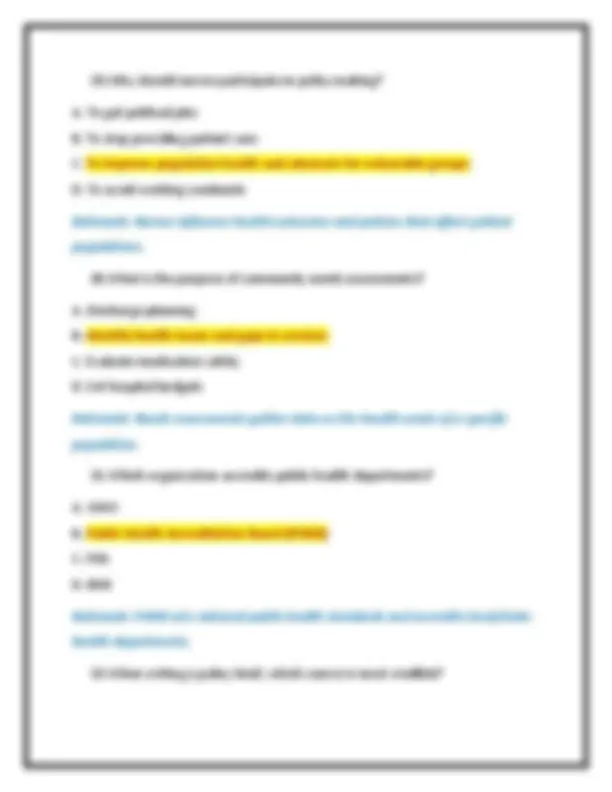
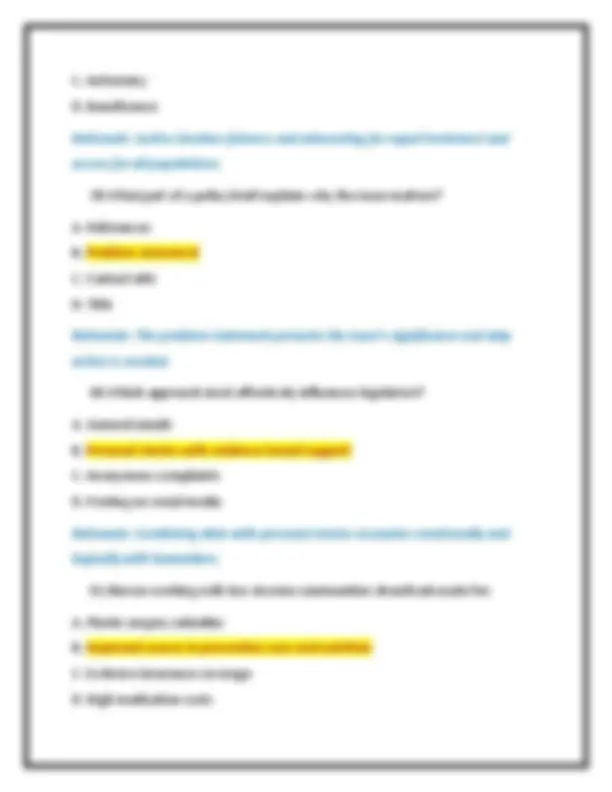
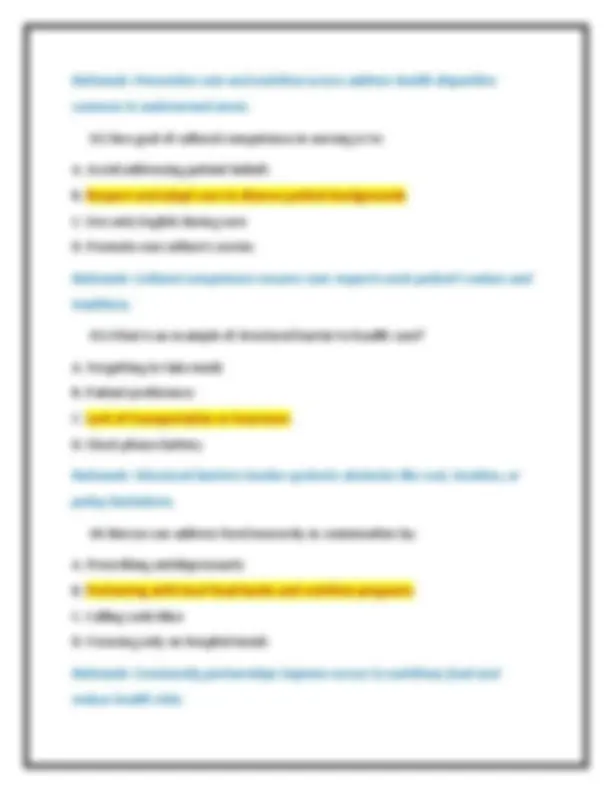
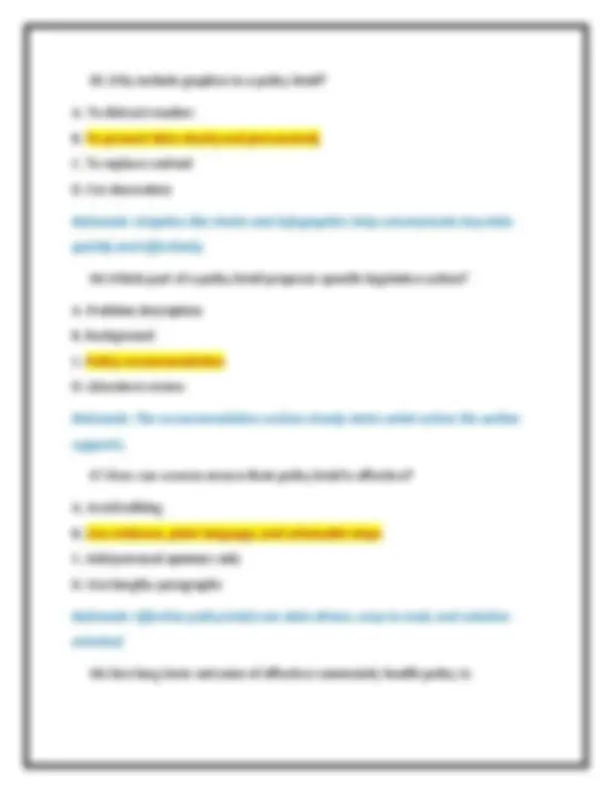
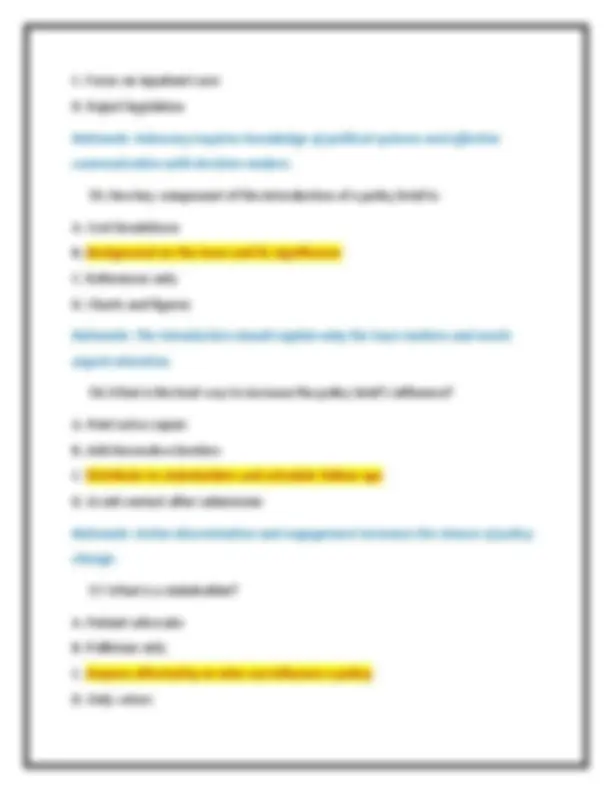
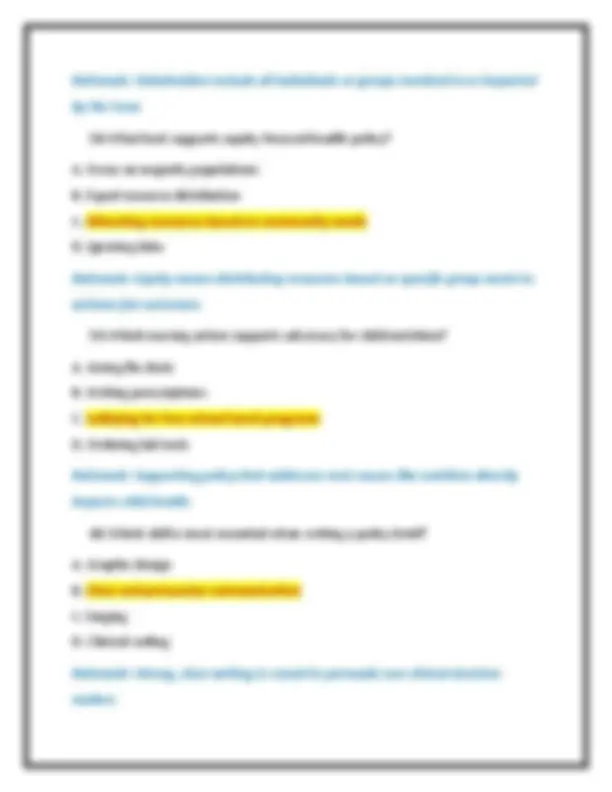
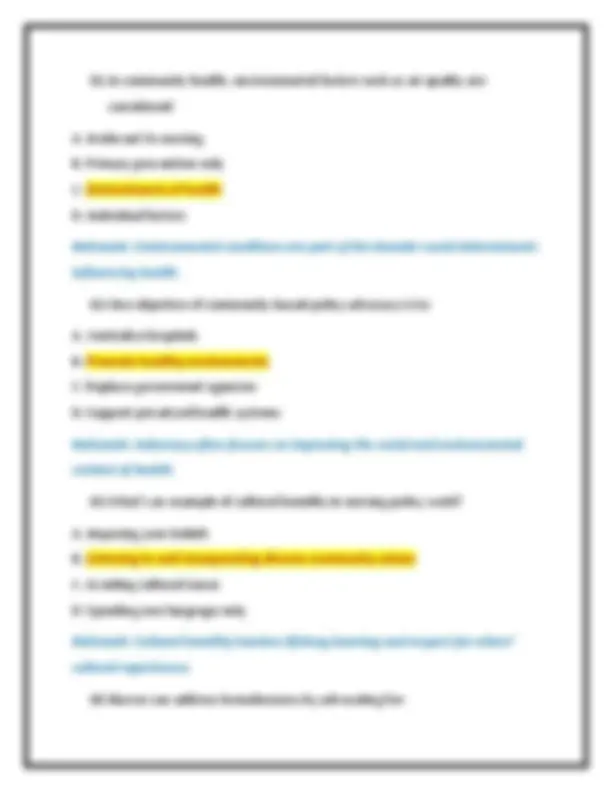
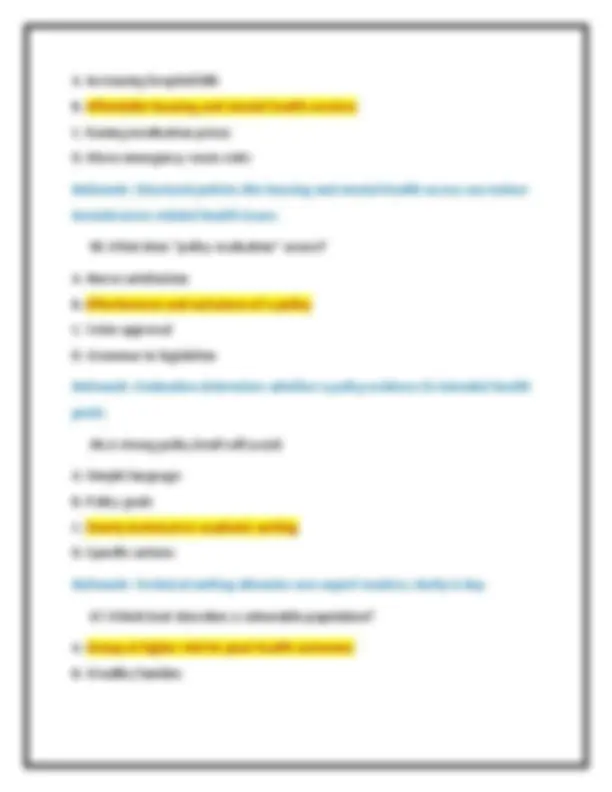
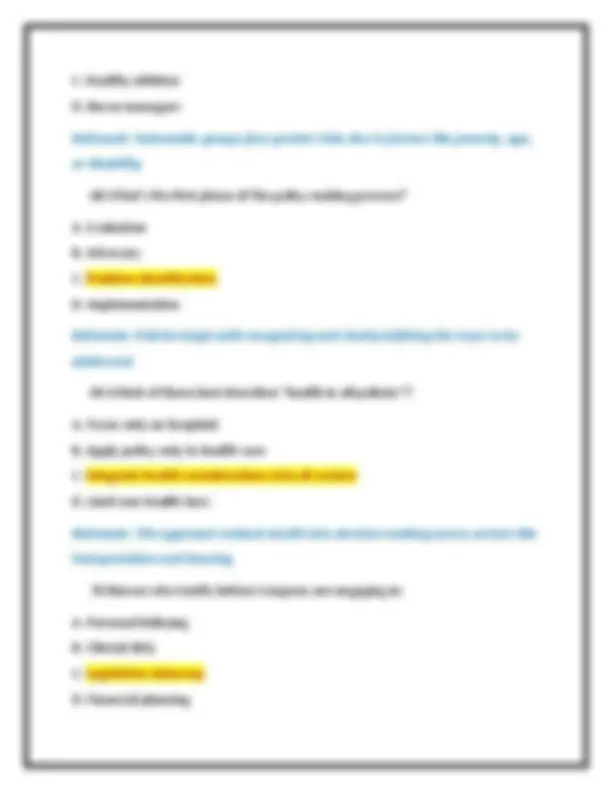

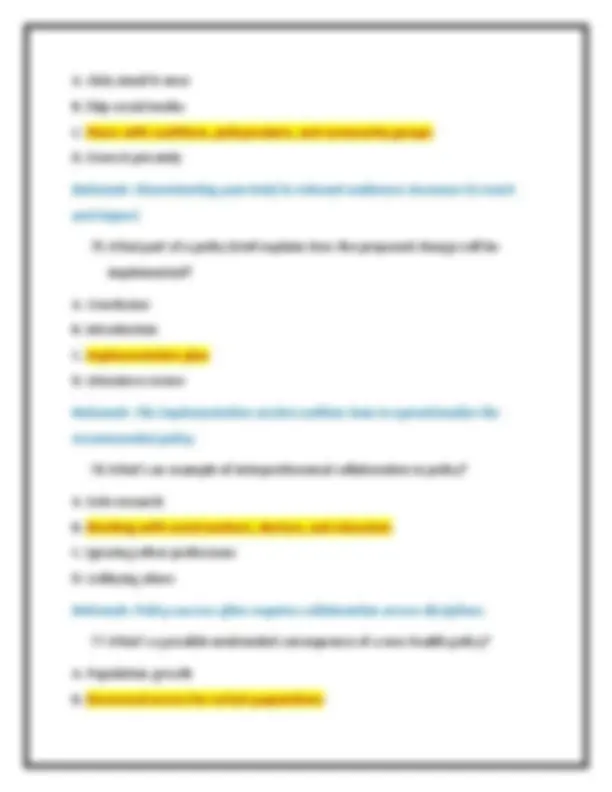
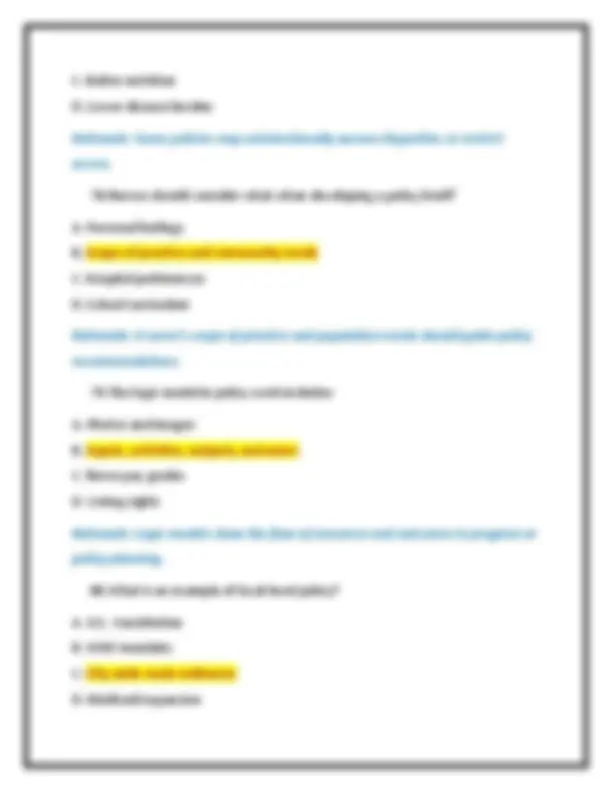
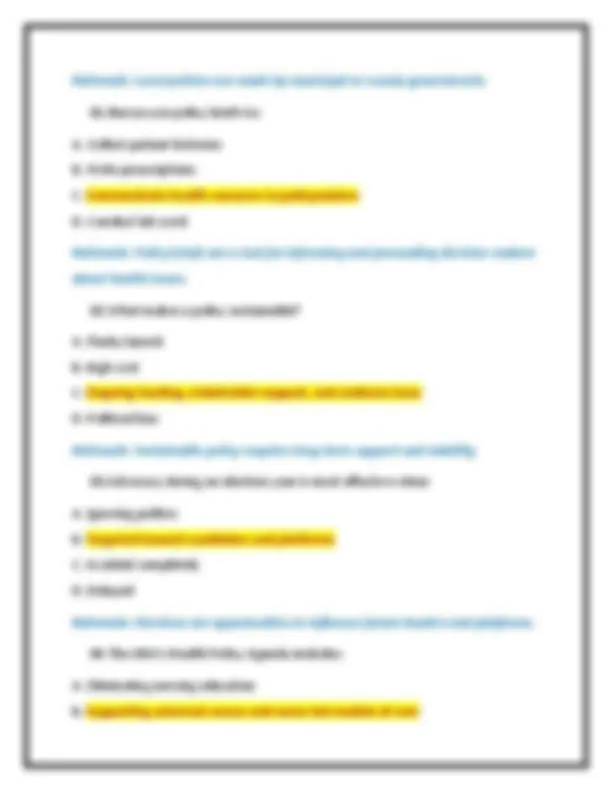
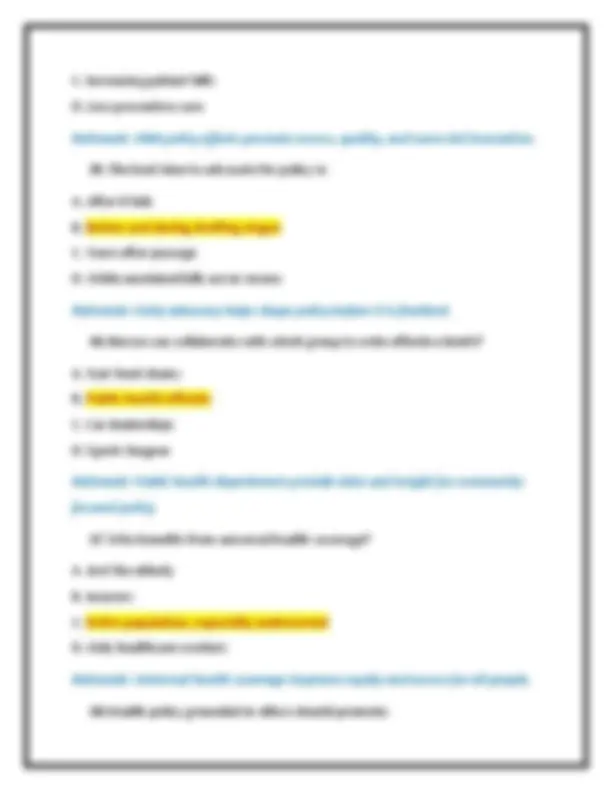
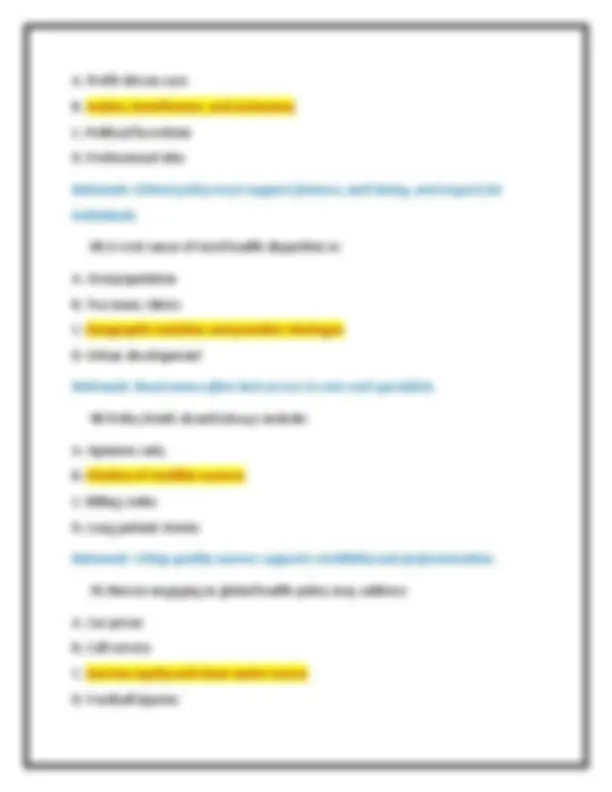
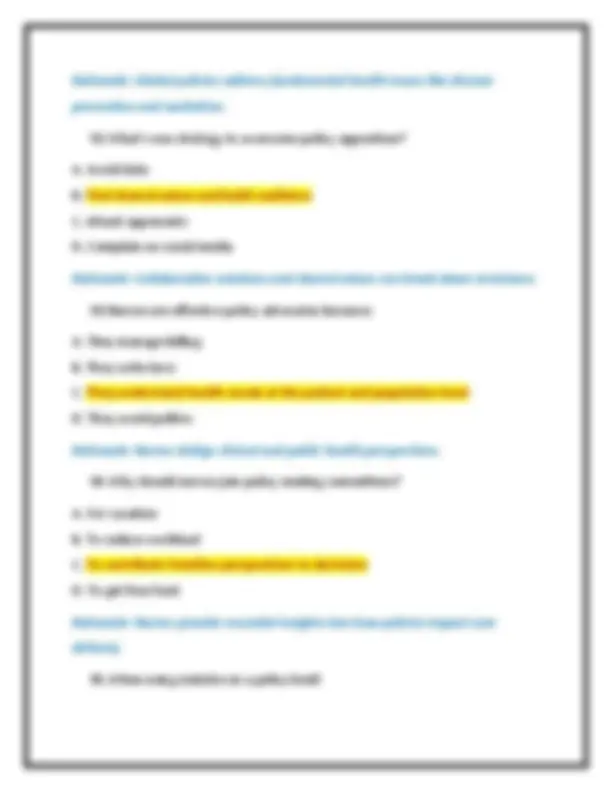
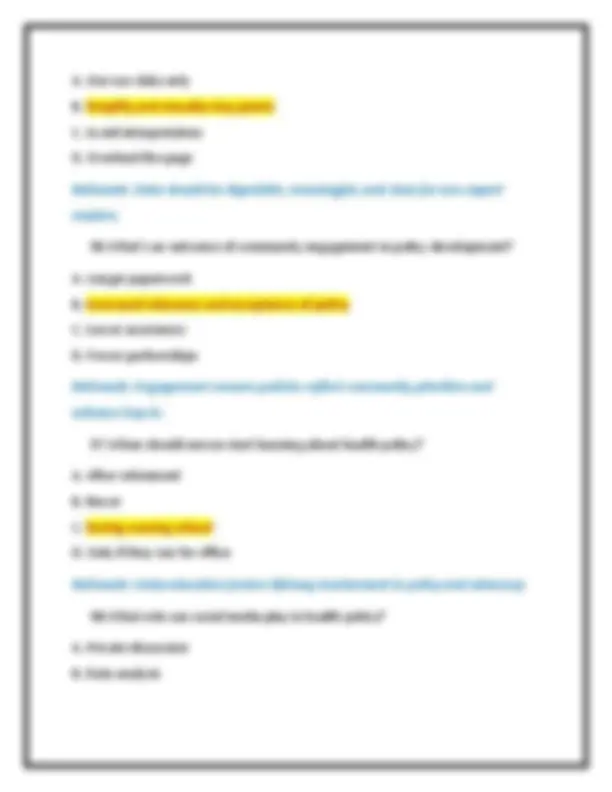



Study with the several resources on Docsity

Earn points by helping other students or get them with a premium plan


Prepare for your exams
Study with the several resources on Docsity

Earn points to download
Earn points by helping other students or get them with a premium plan
Community
Ask the community for help and clear up your study doubts
Discover the best universities in your country according to Docsity users
Free resources
Download our free guides on studying techniques, anxiety management strategies, and thesis advice from Docsity tutors
RN-to-BSN NSG 4533 Community Nursing: Policy Brief course Exam Questions And Correct Answers (Verified Answers) Plus Rationales 2025 Q&A | Instant Download PDF It focuses on public health policy, advocacy, health disparities, determinants of health, and community-focused interventions
Typology: Exams
1 / 31

This page cannot be seen from the preview
Don't miss anything!
























It focuses on public health policy, advocacy, health disparities, determinants of health, and community-focused interventions
C. Universal health insurance D. Healthcare costs Rationale: Health disparities refer to unequal health outcomes often due to socioeconomic factors. 10.An effective policy brief should include: A. Detailed clinical data B. Executive summary and clear recommendations C. Only qualitative data D. Patient testimonials Rationale: Policy briefs summarize an issue and provide a clear call to action with data support. 11.Which is an example of community-level nursing intervention? A. Performing wound care at home B. Educating one patient on diabetes C. Organizing a city-wide vaccination campaign D. Assisting with childbirth Rationale: Community interventions target large populations, not individuals. 12.Which body sets most health policy at the federal level? A. County commissions B. U.S. Congress C. School boards D. City council
Rationale: Federal legislation is passed by Congress and shapes nationwide health policy. 13.What is an example of upstream intervention? A. Treating diabetes complications B. Monitoring hypertension C. Promoting healthy eating in schools D. Dialysis for renal failure Rationale: Upstream interventions prevent disease at the source by addressing social and environmental factors. 14.What’s the best database for health policy research? A. CINAHL B. PubMed C. JSTOR D. LexisNexis Rationale: PubMed provides access to peer-reviewed biomedical and health policy literature. 15.In the policy process, what comes after problem identification? A. Budgeting B. Policy formulation C. Policy evaluation D. Advocacy Rationale: Once a problem is identified, potential solutions are formulated. 16.What should be the first step in writing a policy brief?
C. Increase private insurance profits D. Cut Medicaid funding Rationale: The ACA’s primary purpose is to increase health insurance access and affordability. 20.A “policy window” refers to: A. Hospital visiting hours B. An opportunity for change when problem, policy, and politics align C. Lobbyist schedules D. A deadline for legislation Rationale: A policy window is a strategic time when conditions favor policy adoption. 21.What role do nurses play in shaping health policy? A. Provide bedside care only B. Advocate for patient populations and policy change C. Write insurance plans D. Create tax legislation Rationale: Nurses advocate for populations and influence policy through their expertise and leadership. 22.A well-written policy brief should avoid: A. Policy recommendations B. Technical jargon and lengthy explanations
C. Data visualization D. Evidence-based references Rationale: Policy briefs must be readable and persuasive to a non-technical audience like legislators. 23.Which of the following is a policy advocacy strategy? A. Meeting with a legislator to discuss an issue B. Reading a journal article C. Giving patient discharge instructions D. Calling 911 for emergencies Rationale: Advocacy includes direct engagement with policymakers to influence legislation. 24.Which law expanded nurse practitioner authority in some states? A. HIPAA B. EMTALA C. Affordable Care Act (ACA) D. OSHA Rationale: The ACA supported the expansion of nurse-led care models, especially in underserved areas. 25.What should a nurse include in a policy brief’s executive summary? A. A list of diagnosis codes B. Clear summary of the issue and recommendation C. Historical background only D. Tables and graphs
29.Why should nurses participate in policy making? A. To get political jobs B. To stop providing patient care C. To improve population health and advocate for vulnerable groups D. To avoid working weekends Rationale: Nurses influence health outcomes and policies that affect patient populations. 30.What is the purpose of community needs assessments? A. Discharge planning B. Identify health issues and gaps in services C. Evaluate medication safety D. Set hospital budgets Rationale: Needs assessments gather data on the health needs of a specific population. 31.Which organization accredits public health departments? A. WHO B. Public Health Accreditation Board (PHAB) C. FDA D. NLN Rationale: PHAB sets national public health standards and accredits local/state health departments. 32.When writing a policy brief, which source is most credible?
A. Blog post B. Personal anecdote C. Peer-reviewed journal article D. TikTok video Rationale: Evidence-based, peer-reviewed sources offer reliable data and legitimacy to your brief. 33.What is the focus of a population health approach? A. Health outcomes of entire communities or groups B. Profit margins C. Staffing ratios D. Patient room design Rationale: Population health considers the broader determinants and disparities affecting groups. 34.An example of policy-level intervention is: A. Counseling a smoker B. Passing a city ordinance banning smoking in parks C. Monitoring vital signs D. Replacing IV tubing Rationale: Policy interventions involve legal or regulatory changes that affect communities. 35.What concept is emphasized in Healthy People 2030? A. Achieving health equity and eliminating disparities B. Building hospitals
C. Autonomy D. Beneficence Rationale: Justice involves fairness and advocating for equal treatment and access for all populations. 39.What part of a policy brief explains why the issue matters? A. References B. Problem statement C. Contact info D. Title Rationale: The problem statement presents the issue’s significance and why action is needed. 40.Which approach most effectively influences legislators? A. General emails B. Personal stories with evidence-based support C. Anonymous complaints D. Posting on social media Rationale: Combining data with personal stories resonates emotionally and logically with lawmakers. 41.Nurses working with low-income communities should advocate for: A. Plastic surgery subsidies B. Improved access to preventive care and nutrition C. Exclusive insurance coverage D. High medication costs
Rationale: Preventive care and nutrition access address health disparities common in underserved areas. 42.One goal of cultural competence in nursing is to: A. Avoid addressing patient beliefs B. Respect and adapt care to diverse patient backgrounds C. Use only English during care D. Promote one culture's norms Rationale: Cultural competence ensures care respects each patient’s values and traditions. 43.What is an example of structural barrier to health care? A. Forgetting to take meds B. Patient preference C. Lack of transportation or insurance D. Short phone battery Rationale: Structural barriers involve systemic obstacles like cost, location, or policy limitations. 44.Nurses can address food insecurity in communities by: A. Prescribing antidepressants B. Partnering with local food banks and nutrition programs C. Calling code blue D. Focusing only on hospital meals Rationale: Community partnerships improve access to nutritious food and reduce health risks.
A. Higher medical bills B. Reduced chronic disease burden C. More ICU admissions D. Decreased patient education Rationale: Sound policy helps prevent illness, manage care, and reduce disease over time. 49.Which of the following best represents an upstream solution to obesity? A. Bariatric surgery B. Diet pills C. Improving access to affordable healthy food in neighborhoods D. Daily weigh-ins Rationale: Upstream approaches address root causes and prevent disease, not just treat it. 50.Why is it important for policy briefs to be time-sensitive? A. To align with legislative or budget cycles for maximum impact B. To delay decision-making C. To wait for emergencies D. To match public opinion polls Rationale: Timing is crucial—policy briefs must align with windows of opportunity to influence change. 51.When prioritizing issues in a policy brief, a nurse should consider:
A. Personal interest B. Population impact and feasibility C. Politics alone D. What’s trending online Rationale: Prioritizing based on health impact, urgency, and feasibility ensures actionable policy. 52.What is the best reason to cite peer-reviewed sources in a policy brief? A. To impress readers B. To take up space C. To support arguments with credible evidence D. To confuse legislators Rationale: Peer-reviewed sources strengthen the brief’s credibility and support its recommendations. 53.What type of intervention is a community smoking cessation program? A. Tertiary prevention B. Secondary prevention C. Diagnostic care D. Primary response Rationale: It addresses existing behavior to prevent progression of disease, making it secondary prevention. 54.Nurses involved in advocacy must: A. Avoid public speaking B. Be aware of policy processes and stakeholders
Rationale: Stakeholders include all individuals or groups involved in or impacted by the issue. 58.What best supports equity-focused health policy? A. Focus on majority populations B. Equal resource distribution C. Allocating resources based on community needs D. Ignoring data Rationale: Equity means distributing resources based on specific group needs to achieve fair outcomes. 59.Which nursing action supports advocacy for child nutrition? A. Giving flu shots B. Writing prescriptions C. Lobbying for free school lunch programs D. Ordering lab tests Rationale: Supporting policy that addresses root causes like nutrition directly impacts child health. 60.Which skill is most essential when writing a policy brief? A. Graphic design B. Clear and persuasive communication C. Singing D. Clinical coding Rationale: Strong, clear writing is crucial to persuade non-clinical decision- makers.
61.In community health, environmental factors such as air quality are considered: A. Irrelevant to nursing B. Primary prevention only C. Determinants of health D. Individual factors Rationale: Environmental conditions are part of the broader social determinants influencing health. 62.One objective of community-based policy advocacy is to: A. Centralize hospitals B. Promote healthy environments C. Replace government agencies D. Support privatized health systems Rationale: Advocacy often focuses on improving the social and environmental context of health. 63.What’s an example of cultural humility in nursing policy work? A. Imposing your beliefs B. Listening to and incorporating diverse community values C. Avoiding cultural issues D. Speaking one language only Rationale: Cultural humility involves lifelong learning and respect for others’ cultural experiences. 64.Nurses can address homelessness by advocating for: